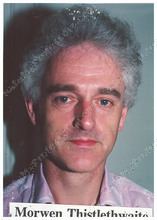Nationality British | Name Morwen Thistlethwaite | |
 | ||
Alma mater University of ManchesterUniversity of LondonUniversity of Cambridge | ||
Academic advisor Michael George Barratt Doctoral advisor Michael George Barratt | ||
Morwen B. Thistlethwaite is a knot theorist and professor of mathematics for the University of Tennessee in Knoxville. He has made important contributions to both knot theory and Rubik's Cube group theory.
Contents
Biography
Morwen Thistlethwaite received his BA from the University of Cambridge in 1967, his MSc from the University of London in 1968, and his PhD from the University of Manchester in 1972 where his advisor was Michael Barratt. He studied piano with Tanya Polunin, James Gibb and Balint Vazsonyi, giving concerts in London before deciding to pursue a career in mathematics in 1975. He taught at the North London Polytechnic from 1975 to 1978 and the Polytechnic of the South Bank, London from 1978 to 1987. He served as a visiting professor at the University of California, Santa Barbara for a year before going to the University of Tennessee, where he currently is a professor. Thistlethwaite's son Oliver is also a mathematician.
Tait conjectures
Morwen Thistlethwaite helped prove the Tait conjectures, which are:
- Reduced alternating diagrams have minimal link crossing number.
- Any two reduced alternating diagrams of a given knot have equal writhe.
- Given any two reduced alternating diagrams D1,D2 of an oriented, prime alternating link, D1 may be transformed to D2 by means of a sequence of certain simple moves called flypes. Also known as the Tait flyping conjecture.
(adapted from MathWorld—A Wolfram Web Resource. http://mathworld.wolfram.com/TaitsKnotConjectures.html)
Morwen Thistlethwaite, along with Louis Kauffman and K. Murasugi proved the first two Tait conjectures in 1987 and Thistlethwaite and William Menasco proved the Tait flyping conjecture in 1991.
Thistlethwaite's algorithm
Thistlethwaite also came up with a famous solution to the Rubik's Cube. The way the algorithm works is by restricting the positions of the cubes into groups of cube positions that can be solved using a certain set of moves. The groups are:
The cube is solved by moving from group to group, using only moves in the current group, for example, a scrambled cube likely lies in group G0. A look up table of possible permutations is used that uses quarter turns of all faces to get the cube into group G1. Once in group G1, quarter turns of the up and down faces are disallowed in the sequences of the look-up tables, and the tables are used to get to group G2, and so on, until the cube is solved.
Dowker notation
Thistlethwaite, along with Clifford Hugh Dowker, developed Dowker notation, a knot notation suitable for computer use and derived from notations of Tait and Gauss.
